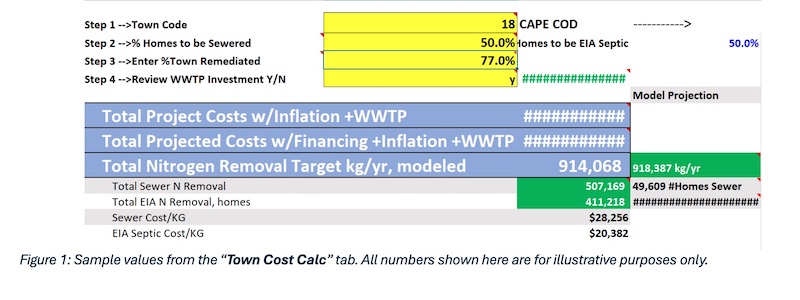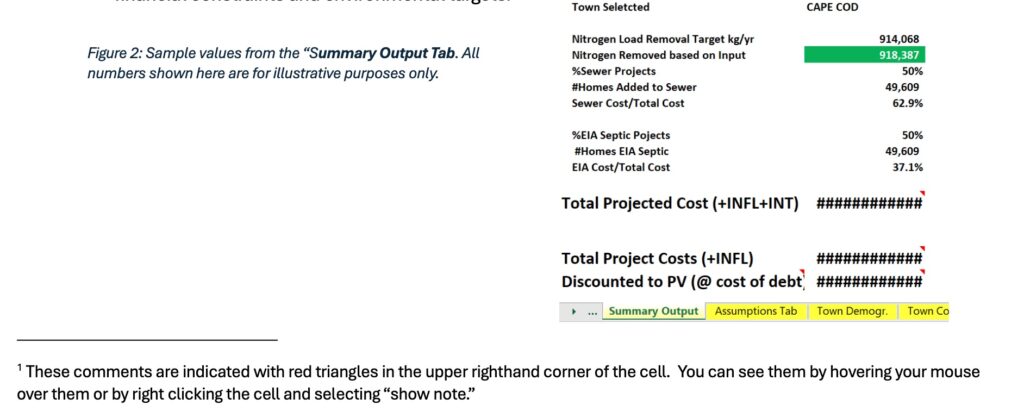
About the Cape Cod Septic and Sewer Financial Planning Tool
The Septic and Sewer Financial Planning Tool provides stakeholders with financial insights to guide preliminary decisions and scenario analyses to improve water quality infrastructure in Cape Cod. This tool aggregates critical financial data previously unavailable, enabling town, state, and federal stakeholders to make informed budget and financing decisions for projects which meet nitrogen reduction goals for both short-term and 20-year project timelines. The intent of this tool is to help users analyze financial and nitrogen reduction impacts of different combinations of sewer and septic improvement projects.
The model incorporates stakeholder insights gathered during the diligence process — including homeowners, towns, states, and the federal government — to inform potential funding approaches. However, it is not designed to provide specific funding solutions or identify definitive financing mechanisms. Weighted averages around homeowner willingness to pay/ability to pay were analyzed based on housing inventory. Homeowner interest rate or other variables may need to be revised.

When to Use This Guide
This guide will help you understand how to navigate the tool and use each of the tool’s six
worksheets, learn how to correctly enter and update data, and how to understand, interpret, and use the tool’s outputs to guide budgeting, planning, and policy decisions. A more in-depth user guide will be available.
Who should use this tool: Planners, financial analysts, municipal leaders, and other stakeholders overseeing environmental infrastructure and budgets.
Why use this tool? Streamlines the evaluation of costs, project scheduling, and nitrogen reduction targets, integrating demographic and financial assumptions for holistic planning.
Who created this model? This model was created by John Stinehour at Sustainable Finance Partners, LLC under a contract with The Nature Conservancy in Massachusetts. It was tested and reviewed by many partners, including members of the NEWEA Innovative/Alternative Onsite Wastewater Treatment Systems Task Force and staff of the Massachusetts Alternative Septic System Test Center.
How do I access the model? Contact David Iorio Izzo at the Massachusetts Alternative Septic System Test Center to access the model and more in-depth training resources at david.iorioizzo@capecod.gov.

Working Tabs for Cape Cod Septic & Sewer Financial Planning Tool
- Summary Output: Aggregates data from all inputs to show cost estimates, nitrogen reduction progress, and overall budget impacts. (See snippet in figure 2.)
- Assumptions: Acts as the “control center” for all financial, project, and scheduling parameters. Changes here flow through the entire workbook.
- Town Demographics: Stores town-level housing and demographic data that inform cost and load calculations.
- Town Cost Calculations: Calculates the total cost of projects, balancing sewer versus septic allocations for each
municipality. (See snippet in figure 1.) - #Projects Cost Calculations: Enables custom phasing over a 20-year timeline, tracking year-by-year costs and nitrogen reductions.
- WWTP Worksheet: Outlines capital and operating expenditures for Wastewater Treatment Plants (WWTP), if included in the plan.

Workflow Guide
This workflow summary gives you a simple starting point for using the tool – Users will be provided a full guide and can use the hover comments throughout the document for additional guidance.
- Gather key data to tailor the model to your purposes, including:
a. System costs, financing interest, and inflation data
b. Number of single-family homes and existing sewered homes
c. If your project requires a new or upgraded wastewater treatment plant (WWTP), add plant-
specific capital and operating expenses. - Adjust cost and nitrogen reduction calculations to meet cost and nitrogen reduction goals.
a. Select a town code to automatically pull housing data or enter your own.
b. Iteratively adjust the number of homes to be connected to sewer, the number that must be
upgraded to meet nitrogen reduction goals, and the resulting ratio of sewer expansions to septic
upgrades to understand how each decision impacts nitrogen reduction and total cost.
c. The model cells will turn green when you’ve met your nitrogen reduction goals. - Use the same process to explore the impacts of different project phasing approaches using #Projects
Cost Calc to design multi-year project schedules and budgets. - Review Final Outputs in Summary Output Tab to confirm that the scenario you’ve built aligns with
financial constraints and environmental targets.

